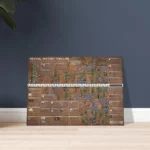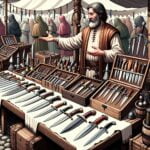The Röttgen Pietà, a wooden sculpture from the early 14th century, offers a stark and moving portrayal of Christ’s suffering and Mary’s grief. Unlike more serene depictions, this piece confronts viewers with the raw reality of death and loss, reflecting the anxieties and spiritual fervor of its time. Join us as we explore the history, symbolism, and enduring power of this remarkable masterpiece.
Unmasking the Agony: Christ’s Suffering and Mary’s Grief
The Röttgen Pietà, crafted in 14th-century Rhineland Germany, distinguishes itself through its raw and unflinching depiction of suffering. Christ’s body, gaunt and contorted, bears exaggerated wounds, suggesting a life of hardship culminating in the agony of crucifixion. Mary’s youthful face, juxtaposed against Christ’s ravaged form, is a mask of anguish, conveying the profound sorrow of a mother facing the unimaginable loss of her child. This intensely personal portrayal of grief allows viewers across centuries to connect with Mary’s pain and the universal human experience of loss. The oversized hands cradling her son’s lifeless form blend tenderness with utter despair, further amplifying the emotional impact.
This visceral realism likely resonated deeply with a 14th-century audience familiar with suffering. The Black Death, a devastating plague that decimated Europe’s population, may have still been a fresh and terrifying memory, influencing the artist’s focus on mortality and pain. Scholars suggest that this widespread experience of death and disease probably shaped the emotional landscape of the time, finding expression in artistic representations like the Röttgen Pietà. Art, in this context, served not only as a religious object but also as a reflection of communal grief and a means of processing shared trauma.
A Window into the Late Medieval World: Context and Style
The Röttgen Pietà exemplifies the key characteristics of Gothic art: emotional intensity, realism (even in its most unsettling forms), and the expression of profound spiritual truths. Unlike the often majestic and untouchable Christ figures of earlier Byzantine art, the Gothic style, particularly in the Röttgen Pietà, embraced the human dimension of suffering, both physical and emotional. This shift likely reflects the evolving religious sensibilities of the time, where mystical piety and an emphasis on Christ’s human vulnerability gained prominence.
The sculpture’s stark realism, far from being gratuitous, served a spiritual purpose. It likely acted as a memento mori, a reminder of mortality and the fleeting nature of life, prompting viewers to contemplate their own spiritual journey and prepare for death. The exaggerated features of Christ’s emaciated body and prominent wounds may have also symbolized the spiritual weight of humanity’s sins, which he bore according to Christian belief.
The Enduring Power of Empathy: Symbolism and Interpretation
The Pietà, as an artistic subject, is rich in symbolism, representing Christ’s sacrifice for humanity and Mary’s immeasurable sorrow. In the Röttgen Pietà, these themes are amplified by the raw intensity of the depiction. Christ’s ravaged body becomes a powerful symbol of the price he paid, while Mary’s anguished expression reflects the universal human experience of loss and grief. The sculpture’s emotional impact transcends time, evoking a range of responses from viewers even today. Some may be repulsed by its graphic realism, while others feel a profound sense of empathy, connecting with the raw emotion displayed. Still others might be drawn into spiritual contemplation, reflecting on sacrifice, redemption, and the mysteries of life and death. This very range of reactions suggests the enduring power of the Röttgen Pietà to engage viewers on multiple levels.
The sculpture, now housed in the Rheinisches Landesmuseum in Bonn, Germany, retains traces of its original polychromed paint, offering a glimpse into its vibrant appearance centuries ago. It stands as a powerful testament to the emotional and spiritual world of the late Middle Ages, a time marked by both intense faith and profound suffering. The Röttgen Pietà continues to invite viewers to confront the reality of human pain and the enduring questions of faith, loss, and the meaning of life and death. Discover the incredible journey of Ruby Bridges and her courageous stand for integration. Immerse yourself in the rich history of San Basilio de Palenque, the oldest free town in the Americas.
Decoding the Symbolism: What Does the Röttgen Pietà Represent?
The Röttgen Pietà is more than just a statue; it’s a poignant reflection of a tumultuous era. This raw, intensely human portrayal of suffering, loss, and faith resonated deeply with people in the 14th century and continues to evoke powerful emotions today. We are not merely observing a depiction of Mary holding the body of her son; we are witnessing a mother’s unimaginable grief mirrored in the collective suffering of a community grappling with hardship. This polychromed wooden sculpture invites us to contemplate not only Christ’s sacrifice but also the very nature of human existence in a world often marked by adversity.
The Röttgen Pietà’s unique power lies in the rawness of its emotional portrayal. Mary is not depicted as a serene, detached religious icon. Instead, her youthful face, framed by heavy robes, is etched with anguish, making her grief palpable. This humanized portrayal of Mary as a grieving mother allows viewers across centuries to connect with her sorrow on a deeply personal level. We see ourselves in her pain, recognizing the universal human response to unimaginable loss. This profound empathy, perhaps, continues to draw people to this emotionally charged piece.
The sculpture’s creation coincided with a period of widespread suffering in the Rhineland region of Germany. The 14th century was marked by plague, famine, and war, making death a constant presence in people’s lives. It is highly probable that many who viewed the Pietà had experienced the very kind of grief it depicts. For them, the sculpture was likely not just a religious image but a mirror reflecting their own lives, losses, and fears. It probably served as a focal point for communal grieving, acknowledging shared human suffering in the face of adversity. It may have also offered a measure of comfort, reminding viewers that they were not alone in their pain.
Beyond the immediate sense of grief, the Röttgen Pietà also suggests deeper theological reflections. Some scholars believe the exaggerated features of Christ’s emaciated body and prominent wounds emphasize not only his physical torment but also the spiritual burden of humanity’s sins. The sculpture might have also served as a memento mori, encouraging viewers to confront their own mortality and contemplate the spiritual significance of life and death.
While ongoing research continues to explore the specific artistic influences and historical context surrounding the Röttgen Pietà’s creation, its core message of empathy, suffering, and faith continues to transcend scholarly debate. This work speaks to something fundamental about the human condition, inviting us to reflect on our own experiences of suffering, loss, and resilience. It may even encourage us to ask: What does suffering mean to us today? How do we cope with loss in our own lives? And where do we find solace in the face of adversity?
Unveiling the Mystery: Who Sculpted the Röttgen Pietà?
The Röttgen Pietà, a masterpiece of late medieval art, presents a powerful and moving depiction of Mary mourning the dead Christ. However, despite its significance, the identity of its creator remains shrouded in mystery. This anonymity adds to the intrigue, prompting ongoing scholarly inquiries and discussions. Who was the artist capable of imbuing such raw emotion and skillful craftsmanship into this evocative sculpture? While we may never know their name with certainty, we can explore the artistic and historical context that shaped their work and appreciate the genius that brought this masterpiece to life.
The Röttgen Pietà is dated to circa 1300-1325, placing it firmly within the Late Gothic period. This era witnessed a significant shift in artistic expression, moving away from the idealized figures of earlier styles towards more emotionally charged and realistic representations. The Röttgen Pietà embodies this stylistic shift, presenting the viewer with an unflinching portrayal of suffering, rather than shying away from its harsh realities.
The sculpture’s details are striking in their realism. Christ’s body is emaciated, with taut skin clinging to his ribs, and his wounds are exaggerated almost to the point of disturbing. This intense focus on physical suffering likely reflects the anxieties of a time marked by plague, war, and social instability. It may have served as a powerful memento mori, reminding viewers of their own mortality and the pervasive presence of suffering in the world.
In contrast to Christ’s ravaged body, Mary is depicted with surprisingly youthful features. However, her expression is one of pure anguish, conveying the profound sorrow of a mother’s loss. This juxtaposition – the young face cradling the aged, suffering body – amplifies the tragedy and makes the image of grief universally relatable across centuries.
The Röttgen Pietà’s emotional impact is complex. It might evoke discomfort or even repulsion at the rawness of Christ’s wounds. Conversely, it can also elicit profound empathy, drawing viewers into Mary’s sorrow and the shared human experience of loss. The sculpture invites a nuanced emotional response, challenging our perceptions of beauty and suffering.
Several theories attempt to link the Röttgen Pietà to specific workshops or artistic circles within the Rhineland region. However, without a signature or documented commission, a definitive attribution remains elusive. Ongoing research may one day reveal the sculptor’s identity, but for now, their name remains a mystery. Yet, even without a name, the artist’s legacy endures through this masterpiece, which continues to move and challenge viewers centuries later. The Röttgen Pietà speaks volumes about the power of art, the depths of human emotion, and the timeless questions of faith and suffering.
| Feature | Description |
|---|---|
| Period | Late Gothic (circa 1300-1325) |
| Subject | Pietà (Mary mourning the dead Christ) |
| Material | Polychromed poplar wood |
| Style | Expressive, emotionally charged, realistic depiction of suffering |
| Significance | Masterpiece of Late Gothic sculpture; powerful depiction of grief and sacrifice; reflects the social and spiritual context of the late medieval period. |
| Artist | Unknown |
| Current Location | Rheinisches Landesmuseum Bonn, Germany |
Our understanding of art history is constantly evolving. New research and discoveries regularly reshape existing interpretations and open up new avenues of inquiry. While we may not have all the answers about the Röttgen Pietà’s creator, the very act of seeking knowledge and engaging in scholarly discussions enhances our appreciation of the artwork’s profound complexity. The enduring questions surrounding the sculpture remind us that even in the absence of definitive facts, artistic exploration and discovery remain vital.
Mastering the Pronunciation: How to Say “Röttgen Pietà”
The Röttgen Pietà, a deeply moving sculpture from the late Middle Ages, captures the raw intensity of Mary’s grief and Christ’s suffering. But how exactly do you pronounce the name of this remarkable artwork? Accurate pronunciation not only enhances understanding but also demonstrates respect for the artwork’s cultural and historical context.
The name “Röttgen Pietà” comprises two parts: “Röttgen,” referring to the village near Bonn, Germany, where the sculpture was discovered, and “Pietà,” the Italian word for “pity” or “compassion,” commonly used in art to describe depictions of Mary mourning Christ.
Let’s break down “Röttgen.” Being German, it includes sounds that might be unfamiliar to English speakers. The “ö” is similar to the “u” in “fur” or the “e” in “her” – a short, rounded vowel. The double “t” is pronounced as a single, crisp “t.” The “g” is hard, as in “garden.” Therefore, “Röttgen” sounds approximately like “RUT-gen,” with the stress on the first syllable. It is worth noting that regional variations in German pronunciation exist, particularly with the “r” sound, but “RUT-gen” is a widely understood approximation.
“Pietà,” being Italian, is perhaps more familiar. The stress falls on the second syllable, the “AY” sound, pronounced like the “a” in “father.” The first “i” is short, as in “pit,” and the final “a” is also short, as in “ah.” Thus, “Pietà” is pronounced “pee-AY-tah.” Minor variations might occur, but this pronunciation is generally accepted in English.
Combining the two parts, the correct pronunciation of “Röttgen Pietà” is “RUT-gen pee-AY-tah.” Practice can help achieve a smoother delivery, but even an approximate pronunciation demonstrates a thoughtful engagement with the artwork and its origins.
Why is accurate pronunciation important? Beyond simply sounding knowledgeable, it signals respect for the artwork’s cultural and historical context. Additionally, it avoids confusion and ensures that everyone understands which masterpiece is being discussed. The Röttgen Pietà remains a powerful and enigmatic work of art. While research continues to unravel its history and the identity of its creator, the sculpture’s emotional impact endures across centuries. Learning to pronounce its name correctly is a small but meaningful step towards appreciating the depth and complexity of this remarkable artwork. It might even inspire you to explore its fascinating story further.
- Revolution Space: Disruptive Ion Propulsion Transforming Satellites - April 24, 2025
- Race Through Space: Fun Family Game for Kids - April 24, 2025
- Unlocking the Universe: reading about stars 6th grade Guide - April 24, 2025
















